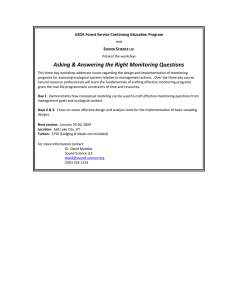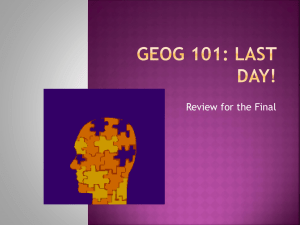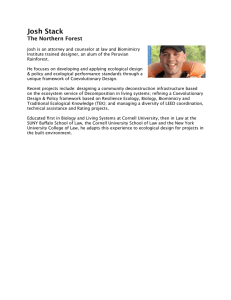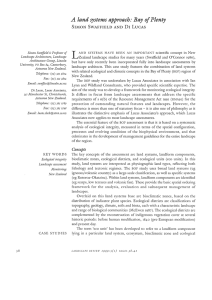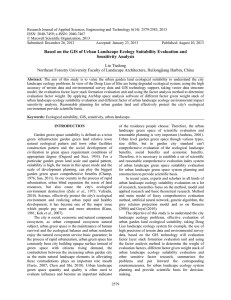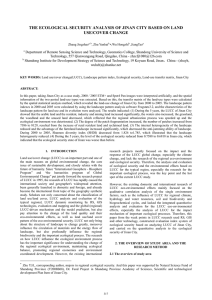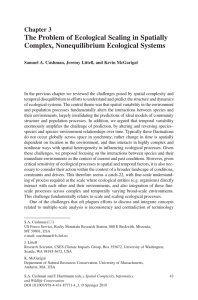Manifesto: Two Rivers Urban Park / draft
advertisement
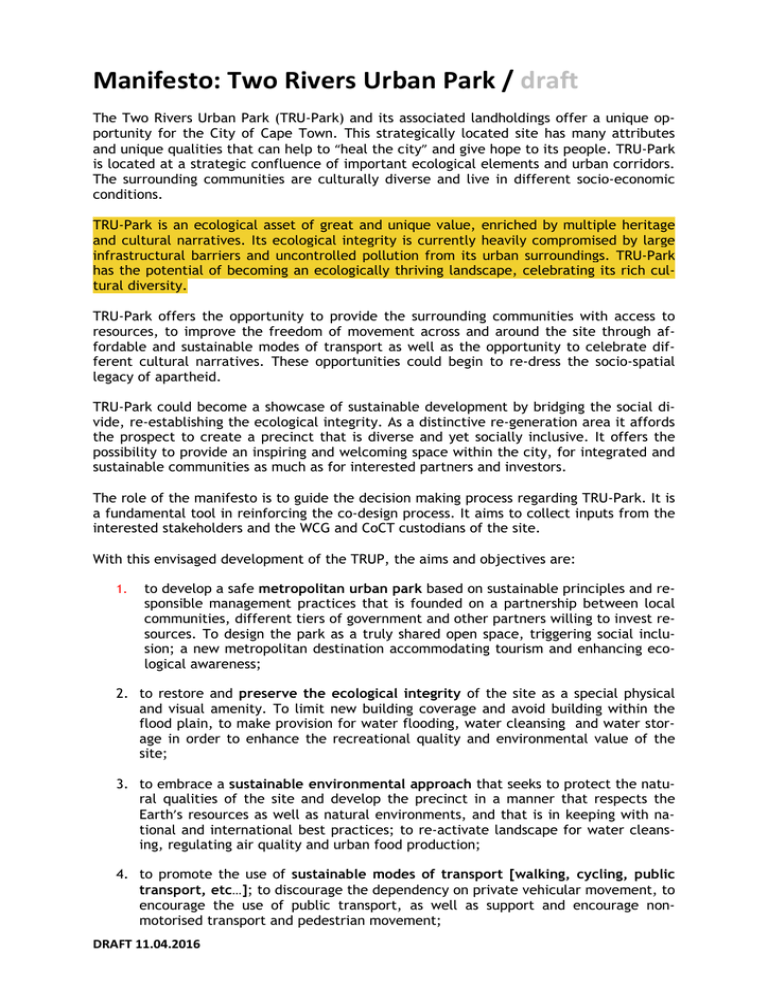
Manifesto: Two Rivers Urban Park / draft The Two Rivers Urban Park (TRU-Park) and its associated landholdings offer a unique opportunity for the City of Cape Town. This strategically located site has many attributes and unique qualities that can help to “heal the city” and give hope to its people. TRU-Park is located at a strategic confluence of important ecological elements and urban corridors. The surrounding communities are culturally diverse and live in different socio-economic conditions. TRU-Park is an ecological asset of great and unique value, enriched by multiple heritage and cultural narratives. Its ecological integrity is currently heavily compromised by large infrastructural barriers and uncontrolled pollution from its urban surroundings. TRU-Park has the potential of becoming an ecologically thriving landscape, celebrating its rich cultural diversity. TRU-Park offers the opportunity to provide the surrounding communities with access to resources, to improve the freedom of movement across and around the site through affordable and sustainable modes of transport as well as the opportunity to celebrate different cultural narratives. These opportunities could begin to re-dress the socio-spatial legacy of apartheid. TRU-Park could become a showcase of sustainable development by bridging the social divide, re-establishing the ecological integrity. As a distinctive re-generation area it affords the prospect to create a precinct that is diverse and yet socially inclusive. It offers the possibility to provide an inspiring and welcoming space within the city, for integrated and sustainable communities as much as for interested partners and investors. The role of the manifesto is to guide the decision making process regarding TRU-Park. It is a fundamental tool in reinforcing the co-design process. It aims to collect inputs from the interested stakeholders and the WCG and CoCT custodians of the site. With this envisaged development of the TRUP, the aims and objectives are: 1. to develop a safe metropolitan urban park based on sustainable principles and responsible management practices that is founded on a partnership between local communities, different tiers of government and other partners willing to invest resources. To design the park as a truly shared open space, triggering social inclusion; a new metropolitan destination accommodating tourism and enhancing ecological awareness; 2. to restore and preserve the ecological integrity of the site as a special physical and visual amenity. To limit new building coverage and avoid building within the flood plain, to make provision for water flooding, water cleansing and water storage in order to enhance the recreational quality and environmental value of the site; 3. to embrace a sustainable environmental approach that seeks to protect the natural qualities of the site and develop the precinct in a manner that respects the Earth’s resources as well as natural environments, and that is in keeping with national and international best practices; to re-activate landscape for water cleansing, regulating air quality and urban food production; 4. to promote the use of sustainable modes of transport [walking, cycling, public transport, etc…]; to discourage the dependency on private vehicular movement, to encourage the use of public transport, as well as support and encourage nonmotorised transport and pedestrian movement; DRAFT 11.04.2016 5. to provide dense mixed-use, mixed tenure urban environment, where appropriate, associated with the Park that is holistic and sustainable. Where-in people can safely live, work and play. In particular, to make provision for medium density affordable housing. To strive towards building a vibrant, safe, local resident community in which cultural diversity and tolerance could flourish; 6. to develop funding and local economic opportunities geared towards sustainable development. These are geared towards community, public and private partnerships as well as the involvement of institutional investors. To mobilise new investments, create jobs and ensure that a significant component of the business premises are affordable for small and micro-enterprises, enhancing human capital and supporting social entrepreneurship. 7. to align the development and the preservation with clear management, administrative and institutional systems. To bring government and public services closer to the people, and where required, to reform legislation. To develop and find new ways and forms of entrepreneurship to ensure sustainability and sustain the quality of the public spaces in the TRU-Park through good urban and environmentally appropriate management; 8. to develop TRUP as an integrative space that responds to culture, heritage and memory of the site – a place that joins together this region of the city and its local communities, rather than continuing to serve as a ‘barrier space’ and therefore, assists in undoing apartheid spatial planning and attending to the needs of the current and future communities. This is to be implemented with sensitivity to the heritage of the site and be inclusive of the diverse cultural characteristics. 9. to establish a social partnership that can form the basis of cooperation between the various stakeholders, which can address the inequalities of the past, include the marginalised sectors of society, prioritise public rather than private interest as well as help build viable enterprises; to enhance existing communities [e.g. Maitland Garden Village], organisations and programmes within the TRU-Park area. 10. to develop, where possible, alternative systems of technology - resource efficient sustainable technologies – that are viable as well as financially feasible and which could demonstrate alternative modes of urban living. TRU-Park as showcase of sustainable living [zero waste, passive design, renewable energy, local materials, climatic responsive design, …] It is these fundamental objectives that are to inform the various principles by which the TRUP project is to be carried out. Public participant processes, policy decision making, management systems, urban design, water engineering and landscape design principles should all be guided by these overarching interests. To ensure success in the way forward, the application of these objectives should be regularly monitored. On this basis, the TRU-Park project can make a meaningful contribution towards an alternative, exciting and sustainable future. DRAFT 11.04.2016

